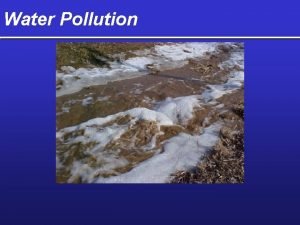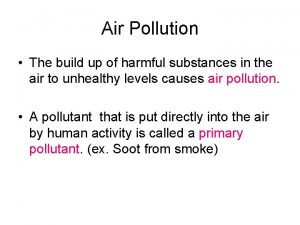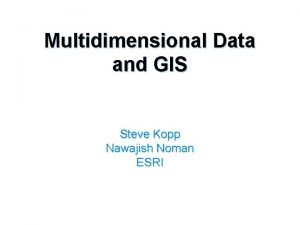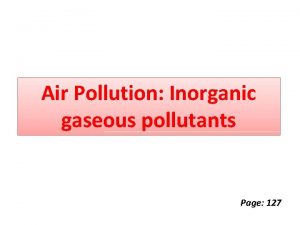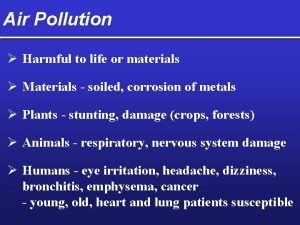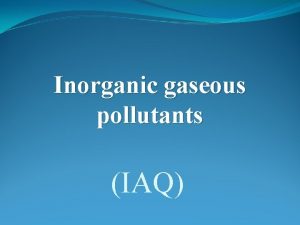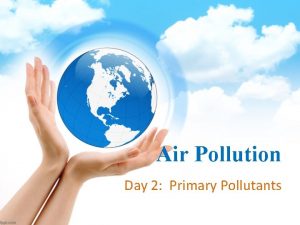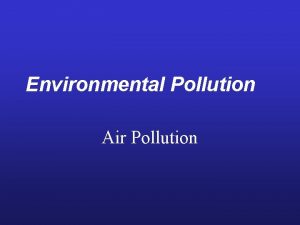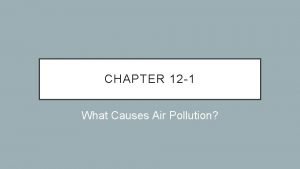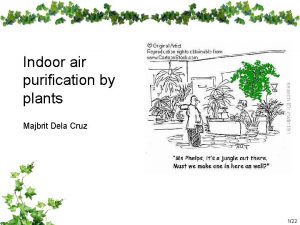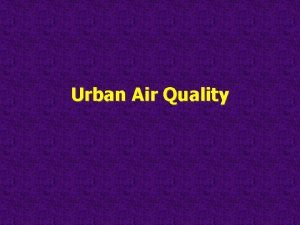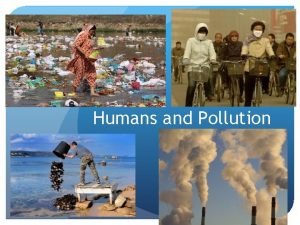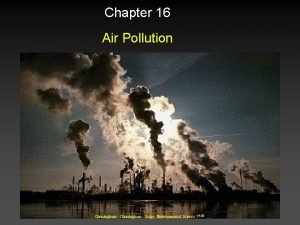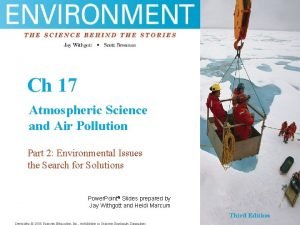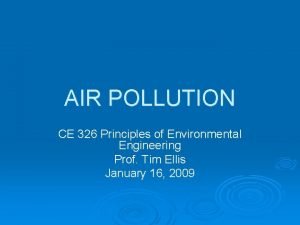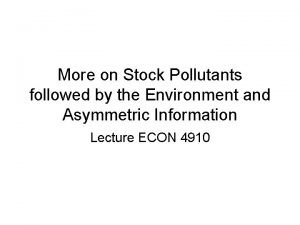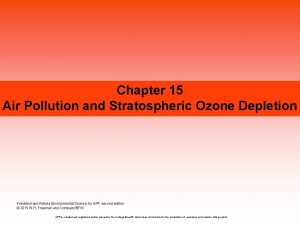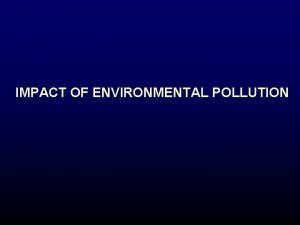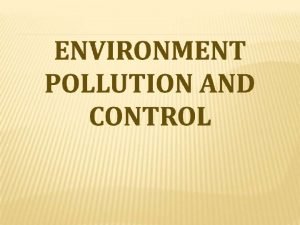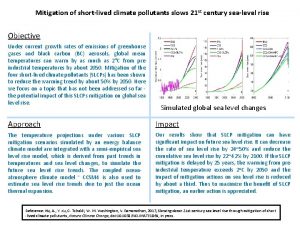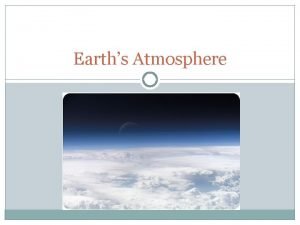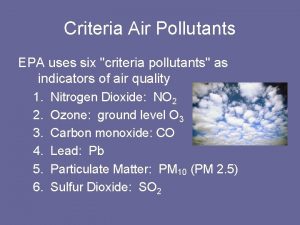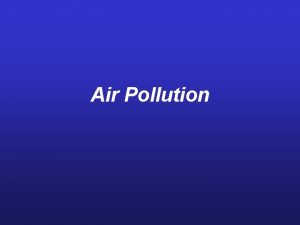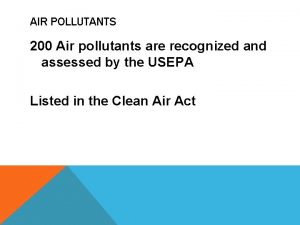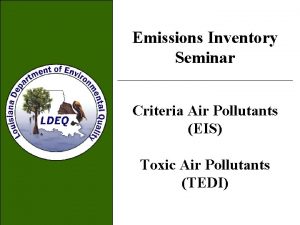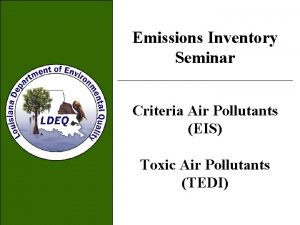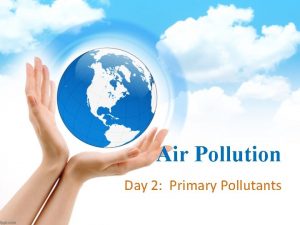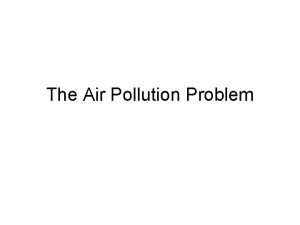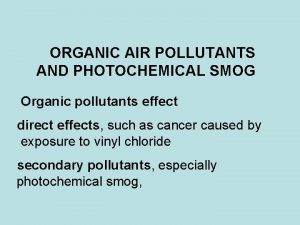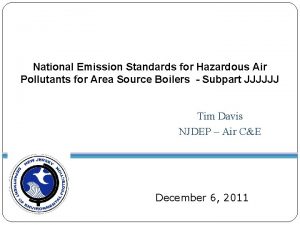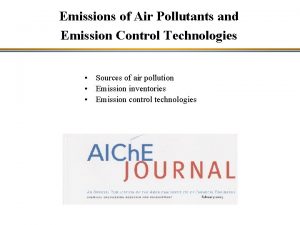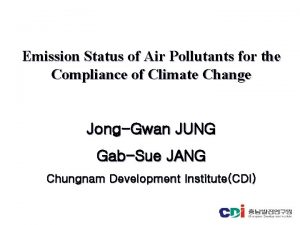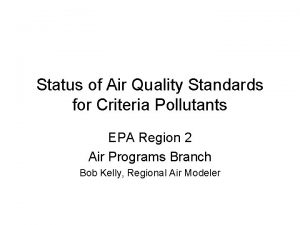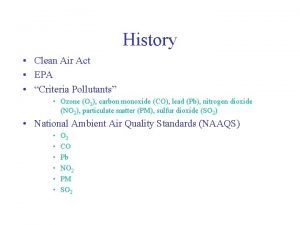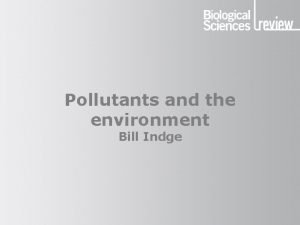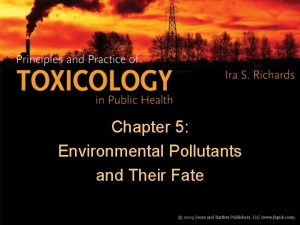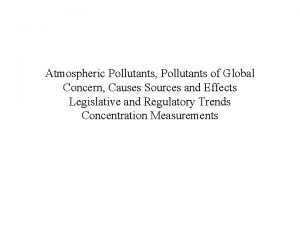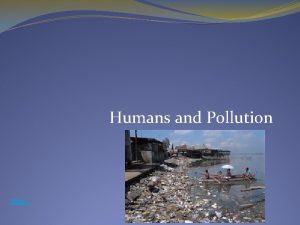Gridded Emission Inventory of Criteria Air Pollutants for









![10 Continued… Considering Sulphur to be 1% [CPCB, 2011] 10 Continued… Considering Sulphur to be 1% [CPCB, 2011]](https://slidetodoc.com/presentation_image_h2/5fba66201193efa22adde9695f6606e8/image-10.jpg)





























- Slides: 39

Gridded Emission Inventory of Criteria Air Pollutants for National Capital Territory, Delhi Rahul Chaurasia 1 Manju Mohan 1 Centre for Atmospheric Sciences 1 Indian Institute of Technology-Delhi General Assembly 2020: European Geoscience Union (EGU) Vienna (Austria) May 3 -8, 2020

2 Contents • Introduction • Methodology • Sectors wise Emission Estimation and Distribution • Conclusion • References

3 Introduction • An estimated 50% of the global population lives in the urban areas and this percentage is projected to reach around 69% by the year 2050. • In India nearly 36% of the total population resides in urban areas. The continuous population growth and the subsequent economic expansion over decades in an unplanned manner have exaggerated the problem of air pollution. • The problem of air pollution and substandard air quality has become the biggest environmental challenge to capital city Delhi. With WHO ranking it as the most polluted city of the world. • It records highest level of exposure to ultra fine particulate matter, PM₂. ₅. • Recorded 12, 322 deaths due to air pollution in 2017 (study published in the Lancet Planetary Health journal).

4 Continued… • In such scenario air quality models provide a tool to understand the implications of pollutant emissions and aid in deciding control and management strategies by predicting the pollutant concentrations. • The emission inventories are helpful in enhancing the model performance through preparation of high resolution emission inventory. • An emission inventory is an accounting of the amount of pollutants discharged into the atmosphere. • An emission inventory contains the total emissions for one or more specific greenhouse gases or air pollutants, originating from all source categories in a certain geographical area and within a specified time span, usually a specific year. • Here, an attempt had been made to prepare emission inventory for Delhi‐ NCT

Methodology q To prepare emission inventory for different sectors and pollutants using latest emission factors. • First part involved collecting data from sources considered like Industrial sources, Power plants, Domestic sector, Transportation sector, Municipal Solid Waste using data on fuel consumption AND latest emission factors. • These emissions were spatially distributed on the grids at a fine resolution of 1 km with the help of Arc‐GIS. 5

Methodology Data Collection Emission factors Emission estimation Activity data Attribute data Emission = ∑Fijhj × EFij Fij= Fuel consumed h Factor EFij= Emission Population, vehicular density, Power plants etc Spatial Distribution Mapping of h Point Locations Interpolation h technique Gridded PM 2. 5 Emission for Delhi Digitization of maps f. Layers Grid overlay 0. 01 ×G 0. 01 6

7 Arc. GIS • Shape files of Delhi, Districts, Industries, Power Plants, Roads (categorised into major, minor and arterial) are prepared using Google Earth Pro. • Using Fishnet Tool (Arc. Map), grids of 1 km*1 km are prepared and projected on Delhi district map. • • Generation of 1484 grids over the study domain are done. • Using base map of ARC view, different LULC can be observed. • Attribute table is used for assigning values to all the grids for different pollutants for various sectors.

8 Sectors Covered 1. Industrial Sector 2. Domestic Sector 3. Transport Sector 4. Power Plant Sector 5. Municipal Sector

9 1. Industrial Sector • 18 Main Industrial areas in Delhi in year 2016 • Fuel used in these industries is mainly Diesel OI Oil (eg. LDO, HSDO) and coal. • Data collected from Delhi Statistical Handbook, (2016) and various CPCB, DPCC reports. • Equation used is Ei = Σ(Fuelj × EFi, j) 1 ü ü ü Ei: emission per pollutant (i) Fuelj: consumption of fuel per fuel type (j) EFi, j: emissions of pollutant (i) per unit of volume(j)
![10 Continued Considering Sulphur to be 1 CPCB 2011 10 Continued… Considering Sulphur to be 1% [CPCB, 2011]](https://slidetodoc.com/presentation_image_h2/5fba66201193efa22adde9695f6606e8/image-10.jpg)
10 Continued… Considering Sulphur to be 1% [CPCB, 2011]

11 Emission Load from Industrial sector (kg/day)

12 Grid Wise Distribution: PM 10 for Industries

13 Continued…

14 Continued…

15 2. Domestic Sector • Total district-wise and ward-wise population of Delhi in year 2016 used • Data for LPG, kerosene, wood, dung obtained from Delhi statistical handbook 2016 • Emission factors from CPCB (2011) • Equations used are Ei = Σ(Fuelj × EFi, j)1 1. Mohan et al. , 2012

16 Continued… • Emissions are distributed on grid system with respect to population density calculated ward wise • Use of LPG was majorly concentrated in urban area with high population density • Rural as well as slum areas use coal, kerosene, cow-dung as cooking fuel.

17 Emission Load from Domestic sources (kg/day)

18 Continued…

19 Continued…

20 Continued…

21 3. Transportation Sector : • Data is taken from C. R. R. I and Delhi Statistical handbook 2016 • Emission factors are based on CPCB(2010) and NEERI • Equation used Ei = Σ(Vehj × Dj) × EFi, j, km 1 Ei: Emission of pollutant (i) Vehj: Number of vehicles per type (j) {Car (Petrol, diesel), Bus (Diesel), Bikes (Petrol), Taxis (Diesel), Auto Rickshaws} Dj: Distance travelled by per vehicle in per year or vehicle utilization factor (j) 2 EFi, j km: Emission of pollutant(i) for vehicle type (j) per driven kilometer 1. IPCC, 2006; Sahu et al. , 2011 2. delhigov. nic. in/transport/sector

22 Continued… • The main 51 major roads in Delhi were digitized using Arc. GIS • Emission on roads is non-uniform because of congestion points which have major portion • 16 major congestion points were identified in Delhi (using various reports) • Number of vehicles on each road per day were obtained from CRRI study report • Fraction of vehicles on each road was found and distribution of emissions was done accordingly • Distribution for minor roads was done on the basis of population density 1 1. [Singh et al. , 2018]

23 Continued… Crop_img

24 Continued…

25 Continued…

26 Continued… • The emission of pollutants varies (in addition to vehicle and fuel type) according to the engine capacity, emission standard, driving conditions and speed of the vehicles • The new generation vehicles also use the hybrid concept to reduce the emissions which is not considered in the study • Over 90% of vehicles on the road use gasoline and diesel fuels. Each kind of fuel has its merits and demerits in terms of driving and emissions • Distance travelled by per vehicle in a year is estimated • Diurnal variation of vehicles not considered

27 4. Power Plants • 5 power plants- Rajghat, Indrapratha, Pragati (2), Badarpur(now permanently closed) • Coal consumption of power plants in the year 2016 obtained from monthly coal statement of thermal power plants issued by Central Electricity Authority(CEA), Ministry of Power • Emission factors are based on literature review [Guttikunda et al, 2012] • PLF, Capacity and coal consumption taken from annual report of CEA

28 Continued… Equation used is Ei = Σ(Fuelj × EFi, j)1 Where; fuel used is calculated as : Fuel use(kt/day)= PLF(%) x Capacity x 24 x 365 x Fossil Fuel used per GWH ; EF= in ton/kt coal

Emission Load from Power Plants (kg/day)

30 Continued…

31 Continued…

32 Continued…

5. Municipal Solid Waste (MSW) : • MSW is not purely biomass, but often includes plastics, rubber, and metal-containing refuse, burning of which releases toxic emissions • In Delhi, 10% of the municipal solid waste generated is burned in the open 1 • Major portion of waste collected is burnt in residential areas, collection sites, and roadsides 2 • There are 3 landfill sites Ghazipur, Okhla, Bhalswa whose small fraction is often burnt 3 1. [Pachauri and Batra, 2001] 2. [Guttikunda and Calori , 2013] 3. [Christian et al. , 2010]

Continued… • • Distribution of emissions according to socioeconomic status as most of the open burning is done near slum areas compared to city area Equation used Pj = Σ(waste generated × 0. 1 × p × EFj/86400) Pj : the emission of pollutant j (g/s); p : the human population; EFj : emission factor of pollutant j (g/kg), waste generated : in (g/capita/day) • Emission factors used from CPCB

35 Comparison of emission estimates of various studies and present study Year Study Area (km 2) PM 10 (Tons/da -y) PM 2. 5 (Tons/d a -y) SO 2 (Tons/da -y) Nox (Tons/da -y) CO (Tons/da -y) 2000 Gurjar et al. (2004) 1483 410. 9# * 309. 5 441 1378 2007 CPCB (2010) 1024 147 * 268 460 374 2010 Sahu et al. (2011) 4550 284 175 * * * 2010 Guttikund a and Calori (2013) 6400 312. 3 172. 2 101. 36 1030. 1 3904 2010 Sindhwan i et al. (2015) 4900 294. 45 * 227. 85 937. 81 3534 2016 Present Study 1483 109 110 488 669 727 # Estimated for PM * Did not Estimated

36 Conclusion • The comparison with other studied shows that there is considerable increase in total emission of each and every pollutants unabated • Since the study uses CPCB emission factors, mainly; it is clearly seen that there is huge hike in the emissions of each pollutant. • In case Nox and CO the increase in almost double owing to increase in the total numbers of vehicles in the Capital territory.

37 References • Bamniya, B. R. , Kapoor, C. S. , Kapoor, K. , & Kapasya, V. (2012). Harmful effects of air pollution on physiological activities of Pongamia pinnata (L. ) Pierre. Clean Technologies and Environmental Policy, 14(1), 115‐ 124. • Bandyopadhyay, A. (2011). Air pollution control in ferroalloy manufacturing industries: an Indian regulatory assessment. Clean Technologies and Environmental Policy, 13(3), 421‐ 429. • Beelen, R. , Hoek, G. , Pebesma, E. , Vienneau, D. , de Hoogh, K. , Briggs, D. J. (2009). Mapping of background air pollution at a fine spatial scale across the European Union. The Science of the Total Environment 407, 1852Ͳ 1867 • Brunekreef, B. , & Holgate, S. T. (2002). Air pollution and health. The lancet, 360(9341), 1233‐ 1242. • Clarke, K. , Kwon, H. O. , & Choi, S. D. (2014). Fast and reliable source identification of criteria air pollutants in an industrial city. Atmospheric environment, 95, 239‐ 248. • Firdaus, G. , & Ahmad, A. (2011). Changing air quality in Delhi, India: determinants, trends, and policy implications. Regional Environmental Change, 11(4), 743‐ 752. • Furlan, C. M. , Domingos, M. , & Salatino, A. (2007). Effects of initial climatic conditions on growth and accumulation of fluoride and nitrogen in leaves of two tropical tree species exposed to industrial air pollution. Science of the total environment, 374(2‐ 3), 399‐ 407. • Gambhir, A. , Napp, T. A. , Emmott, C. J. M. , Anandarajah, G. (2014). India's CO₂ emissions pathways to 2050: Energy system, economic and fossil fuel impacts with and without carbon permit trading. Energy , 77, 791‐ 801. • Goswami, P. , Barua, J. (2008). Simulation of daily variation of suspended particulate matter over Delhi: relative roles of vehicular emission, dust, and domestic appliances. Monthly Weather Review, 136 , pp. 3597‐ 3607. • Goyal, P. , Mishra, D. , Kumar, A. (2013). Vehicular emission inventory of criteria pollutants in Delhi. Springer Plus, 2(1), 216. • Gurjar, B. R. , Van Aardenne, J. A. , Lelieveld, J. , & Mohan, M. (2004). Emission estimates and trends (1990– 2000) for megacity Delhi and implications. Atmospheric Environment, 38(33), 5663‐ 5681. • Guttikunda, S. K. , & Calori, G. (2013). A GIS based emissions inventory at 1 km× 1 km spatial resolution for air pollution analysis in Delhi, India. Atmospheric Environment, 67, 101‐ 111. . • HEI (2004). International Scientific Oversight Committee, 2004. • Jiang, P. , Chen, Y. , Geng, Y. , Dong, W. , Xue, B. , Xu, B. , & Li, W. (2013). Analysis of the co‐benefits of climate change mitigation and air pollution reduction in China. Journal of Cleaner Production, 58, 130‐ 137. • U. , Prakash, A. , & Jain, V. K. (2008). A photochemical modelling approach to investigate O 3 sensitivity to NOx and VOCs in the urban atmosphere of Delhi. Aerosol Air Quality. Res, 8, 147‐ 159.

References • Kandlikar, M. (2007). Air pollution at a hotspot location in Delhi: detecting trends, seasonal cycles and oscillations. Atmospheric environment, 41(28), 5934‐ 5947. • Kanada, M. , Fujita, T. , Fujii, M. , & Ohnishi, S. (2013). The long‐term impacts of air pollution control policy: historical links between municipal actions and industrial energy efficiency in Kawasaki City, Japan. Journal of cleaner production, 58, 92‐ 101. • Koper J. , Siwik‐Ziomek, A. (2005). Sulphur content and arylsulphatase activity in soil after longterm fertilization. J. Elem. , 10(2): 369‐ 377. • Li, Y. T. , Chen, N. L. , Zhang, D. W. , Sun, R. W. , Dong, X. , Sun, N. D. , Chen, C. , 2015. Background concentration of PM 2. 5 at different directions in Beijing in 2013. Environ. Sci. 36, 4331– 4339. • Mao, H. , & Talbot, R. (2004). O 3 and CO in New England: Temporal variations and relationships. Journal of Geophysical Research: Atmospheres, 109(D 21). • Mc. Carthy, M. C. , Hafner, H. R. , & Montzka, S. A. (2006). Background concentrations of 18 air toxics for North America. Journal of the Air & Waste Management Association, 56(1), 3‐ 11. • Mc. Kendry, I. G. , Stahl, K. , & Moore, R. D. (2006). Synoptic sea‐level pressure patterns generated by a general circulation model: comparison with types derived from NCEP/NCAR re‐analysis and implications for downscaling. International Journal of Climatology, 26(12), 1727‐ 1736. • Miller, C. A. , Hidy, G. , Hales, J. , Kolb, C. E. , Werner, A. S. , Haneke, B. , & Pennell, B. (2006). Air emission inventories in North America: A critical assessment. Journal of the Air & Waste Management Association, 56(8), 1115‐ 1129. • Mitra, A. P. , & Sharma, C. (2002). Indian aerosols: present status. Chemosphere, 49(9), 1175‐ 1190. • Mobley, D. , Deslauriers, M. , Feldman, H. , Frey, C. , Rojas‐Bracho, L. , Wieman, S. G. , & Werner, A. S. (2005, September). Improving Emission Inventories for Effective Air Quality Management Across North America. In NOAA/EPA Golden Jubilee Symposium on Air Quality Modeling and Its applications (p. 1). • Moraes, R. M. , Klumpp, A. , Furlan, C. M. , Klumpp, G. , Domingos, M. , Rinaldi, M. C. S. , & Modesto, I. F. (2002). Tropical fruit trees as bioindicators of industrial air pollution in southeast Brazil. Environment International, 28(5), 367‐ 374. • Nagpure, A. S. , & Gurjar, B. R. (2012). Development and evaluation of vehicular air pollution inventory model. Atmospheric environment, 59, 160‐ 169. • Nagpure, A. S. , Sharma, K. , & Gurjar, B. R. (2013). Traffic induced emission estimates and trends (2000– 2005) in megacity Delhi. Urban Climate, 4, 61‐ 73. • Narain, U. , & Bell, R. G. (2006). Who changed Delhi's air. Economic and Political Weekly, 1584‐ 1588. • PHFI (2017). Air Pollution and Health in India: A review of the current evidence and opportunities for the future. Public Health Foundation of India and Centre for Environmental Health. (https: //www. ceh. org. in/wp‐content/uploads/2017/10/Air‐Pollution‐and‐Health‐in‐ India. pdf). • Sahu, S. K. , Beig, G. , & Parkhi, N. S. (2011). Emissions inventory of anthropogenic PM 2. 5 and PM 10 in Delhi during Commonwealth Games 2010. Atmospheric Environment, 45(34), 6180‐ 6190. • Wang, Z. F. , Seah, Y. P. , & Wang, Z. P. (2013). Seamless joining of porous membrane with thermoplastic microfluidic devices. Microelectronic Engineering, 110, 386‐ 391. 38

39 Thank You
 Planting more trees
Planting more trees Primary pollutants and secondary pollutants
Primary pollutants and secondary pollutants Air pollutants primary and secondary
Air pollutants primary and secondary Net cdf
Net cdf Fsa achievement level descriptors 2020
Fsa achievement level descriptors 2020 Fsa gridded response
Fsa gridded response Inorganic gaseous pollutants of air
Inorganic gaseous pollutants of air Secondary air pollutants
Secondary air pollutants Inorganic gaseous pollutants of air
Inorganic gaseous pollutants of air What are the secondary air pollutants
What are the secondary air pollutants Major air pollutants
Major air pollutants Air pollutants
Air pollutants Indoor air pollution sources
Indoor air pollution sources Hubungan air dengan tanah
Hubungan air dengan tanah Secondary pollutants examples
Secondary pollutants examples What is secondary pollutant
What is secondary pollutant Primary vs secondary pollutants
Primary vs secondary pollutants Ozone layer depletion
Ozone layer depletion Primary vs secondary pollutants
Primary vs secondary pollutants Stock pollutants
Stock pollutants Primary and secondary pollutants difference
Primary and secondary pollutants difference Definitions of pollution
Definitions of pollution Environmental pollution define
Environmental pollution define Short lived climate pollutants
Short lived climate pollutants Solar energy and the atmosphere
Solar energy and the atmosphere Fspos vägledning för kontinuitetshantering
Fspos vägledning för kontinuitetshantering Typiska novell drag
Typiska novell drag Nationell inriktning för artificiell intelligens
Nationell inriktning för artificiell intelligens Ekologiskt fotavtryck
Ekologiskt fotavtryck Varför kallas perioden 1918-1939 för mellankrigstiden?
Varför kallas perioden 1918-1939 för mellankrigstiden? En lathund för arbete med kontinuitetshantering
En lathund för arbete med kontinuitetshantering Särskild löneskatt för pensionskostnader
Särskild löneskatt för pensionskostnader Personlig tidbok fylla i
Personlig tidbok fylla i Sura för anatom
Sura för anatom Förklara densitet för barn
Förklara densitet för barn Datorkunskap för nybörjare
Datorkunskap för nybörjare Boverket ka
Boverket ka Hur skriver man en debattartikel
Hur skriver man en debattartikel Autokratiskt ledarskap
Autokratiskt ledarskap Nyckelkompetenser för livslångt lärande
Nyckelkompetenser för livslångt lärande
